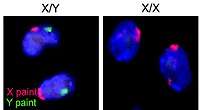Feminization (biology)
| Part of a series on |
| Sex |
|---|
 |
| Biological terms |
| Sexual reproduction |
| Sexuality |
|
In biology and medicine, feminization is the development in an organism of physical characteristics that are usually unique to the female of the species. This may represent a normal developmental process, contributing to sexual differentiation. Feminization can also be induced by environmental factors, and this phenomenon has been observed in several animal species.[1][2] In the case of transgender hormone therapy, it is intentionally induced artificially.
Pathological feminization
In animals, when feminization occurs in a male, or at an inappropriate developmental age, it is often due to a genetic or acquired disorder of the endocrine system. In humans, one of the more common manifestations of abnormal feminization is gynecomastia, the inappropriate development of breasts which may result from elevated levels of feminizing hormones such as estrogens.[3] Deficiency or blockage of virilizing hormones (androgens) can also contribute to feminization. In some cases, high levels of androgens may produce both virilizing effects (increased body hair, deepened voice, increased muscle mass, etc.) and feminizing effects (gynecomastia) since androgens can be converted to estrogens by aromatase in the peripheral tissues.[3]
See also
References
- ↑ DM Fry and CK Toone (1981). DDT-induced feminization of gull embryos Science, Vol 213, Issue 4510, 922-924
- ↑ Sylvia Gimeno, Anton Gerritsen, Tim Bowmer & Hans Komen Feminization of male carp Nature 384, 221 - 222 (21 November 1996); doi:10.1038/384221a0
- 1 2 Larsen, P. Reed; Williams, Robert L. (2003). Williams textbook of endocrinology. Philadelphia: W.B. Saunders. ISBN 0-7216-9184-6.